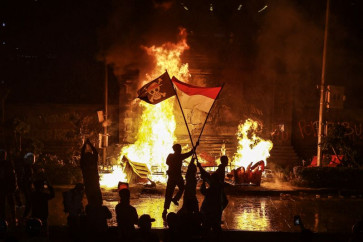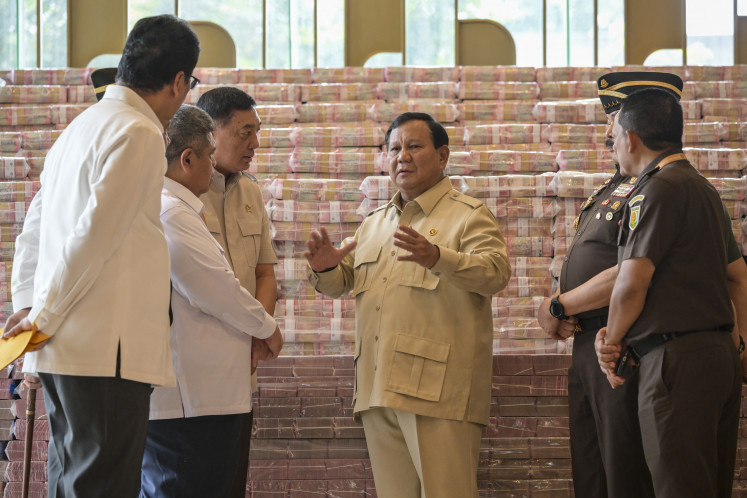Popular Reads
Top Results
Can't find what you're looking for?
View all search resultsPopular Reads
Top Results
Can't find what you're looking for?
View all search resultsBerhala Island: Spooky name gorgeous landscape
Berhala Island is crowded with thousands of visitors mostly from nearby regencies and Jambi city during the Idul Fitri holidays, but this beautiful tourist spot in Sadu district, Tanjung Jabung Timur (Tanjabtim) regency, Jambi, is again quiet following the festival
Change text size
Gift Premium Articles
to Anyone
B
erhala Island is crowded with thousands of visitors mostly from nearby regencies and Jambi city during the Idul Fitri holidays, but this beautiful tourist spot in Sadu district, Tanjung Jabung Timur (Tanjabtim) regency, Jambi, is again quiet following the festival.
Peaceful: A scenery of Barhala island beach is seen. The island is known for its white sand around the beach. — Photo by Jogi Sirait
With no particular means of sea transport available, the island can be reached by chartering speed boats or fishermen’s pompong boats, at a cost of about Rp 1 million (US$112) in around two hours on average. The first route is from Ancol, in Jambi city, via Sungai Itik or Sungai Lokan village, Sadu, and the second from Suakkandis, Muaro Jambi regency, via Nipahpanjang.
From Ancol, one can also go by regular speedboat for Rp 55,000 but it won’t depart for an indefinite length of time until it’s packed to capacity, which may take over two hours while it’s still a long way to the destination.
Tourists also need to have the guts to sail to the island especially if they choose speedboats, because they can be rocked by high waves. Fishermen hiring out their boats depend on weather conditions, too. In October, as sea winds are not strong, there are no huge waves. With the winds changing every two months, the reverse is true in August.
Neglected: The island is now almost empty as many families resettled by the Jambi provincial government in 2005 have left Berhala Island. — Photo by Jogi Sirait
Berhala Island, covering an area of 60 hectares, is located in the Strait of Berhala, east of Sumatra, some 12 miles from the coast of Tanjabtim. It has a sloping western beach and coral eastern bank, amid five islets named Telur or Sisik, Layak, Lampu or Nyirih, Celumar and Tanjung Hantu Laut.
Of the five, Telur and Lampu are more popular. Telur (eggs) is so called due to the presence of numerous turtle eggs, which sometimes are hunted. Lampu (lamp) is named after the lighthouse built there.
Apart from its historical relics and natural scenery, Berhala Island is known for its submarine treasure. A number of divers are frequenting the island to observe its magnificent undersea world. Agus Sudaryadi from the Jambi Heritage Conservation Center recently dived only 5 meters deep and was able to find a vast field of colorful gorgonians, or horny corals.
For living: The island’s residents sundry small fish along the beach. Most of the residents are fishermen.— Photo by Jogi Sirait
In addition, according to Agus, a vessel from Thailand is believed to have sunk around Berhala Island. “It was known after a fisherman’s net caught Thai jugs about five years ago,” he added.
In the past, Berhala Island was known by different names, such as Dakjal, Bratail, Bertayil or Afgorl (Dutch), Birella (Portuguese author Tome Pires), Verrela (Portuguese), and even Hantu (ghost) Island.
Its spooky name doesn’t affect its gorgeous landscape, though. White sands surround the island, with very tall quartz rocks scattered near its quay, resort and amid half-century-old coconut trees. The trees cover the island almost to the peak of its 200-meter-high hills. Berhala waters are green rather than blue and it takes six hours to circle the island on foot while the tide is ebbing.
Among the island’s historic sites is the tomb of Datuk Paduko Berhalo, the founder of Jambi’s Malay kingdom, situated at a halfway point uphill. The island’s present name is derived from Paduko Berhalo.
There are two versions of Paduko Berhala’s origin. The first maintains that he was a Turkish aristocrat who was propagating Islamic teachings. He was also known as Akhmad Barus II. Based on the Tanjabtim regency administration’s historical records, he was the son of a Turkish king.
The second account says that Datuk Paduko Berhalo was descended from a Majapahit royal family member in Java called Adityawarman. As indicated by Prof. Aulia Tasman — now Assistant Rector IV at Jambi University — Adityawarman left Majapahit for failing to become king. Frustrated, he wandered to the Malay land where he married a Malay princess.
The title Paduko Berhalo was given by Muslims instead of Buddhists, because in Islam a worshiped statue is called berhala (idol). It means Adityawarman’s statue is called Datuk Paduka Berhala Adityawaraman, now familiarly known as Datuk Paduka Berhalo. In the last 2-3 years, however, most of the 53 families resettled by the Jambi provincial government in 2005 have left Berhala Island, so have Jambi’s indigenous people. Moreover, educational and health services have no longer been provided for a year now despite the presence of a primary school.
In the last 2-3 years, however, most of the 53 families resettled by the Jambi provincial government in 2005 have left Berhala Island, so have Jambi’s indigenous people. Moreover, educational and health services have no longer been provided for a year now despite the presence of a primary school.
Head of a local hamlet, Junaedi, said that six years ago, when he first settled on the island, there were lots of tourists, including foreign visitors. “They came here because of the beauty and tranquility of Berhala so they felt comfortable,” he noted. During school vacations, groups of students also used to stay there.
The situation has drastically changed in the last two years, with no foreign tourists and student groups visiting Berhala. “This island is getting even more deserted,” added Junaedi.
Since 2006, Jambi province has no longer allocated funds for the island through Tanjabtim regency. Head of Jambi’s Provincial Tourism Office, Didy Wurjanto, admitted that some time ago his office stopped providing tourism development funds for Berhala.
The island has been neglected following a dispute in 1981 over its control between the provinces of Jambi and Riau Islands. It has become a disputed area for such a long time that Jambi Governor Hasan Basri Agus in November last year said he even had no objection if Berhala had to be divided and shared with Riau.
Amid the long wait, there was good news in early October. Home Minister Gamawan Fauzi decided to include Berhala Island in the administrative region of Jambi province under his Decree No.44/2011 dated Sept. 29, 2011.
Conversely, Riau Islands Governor HM Sani declined to accept the decision. On Oct. 26, he proposed the idea of changing the name of Berhala to Berlian Island.
Pressure also came from a group calling itself the Community Alliance for Riau Islands’ Integrity (Amuk Kepri), which staged a demo at the Home Minister’s office on October 19, demanding the revocation of his recent decision.
— Photos by Jogi Sirait












